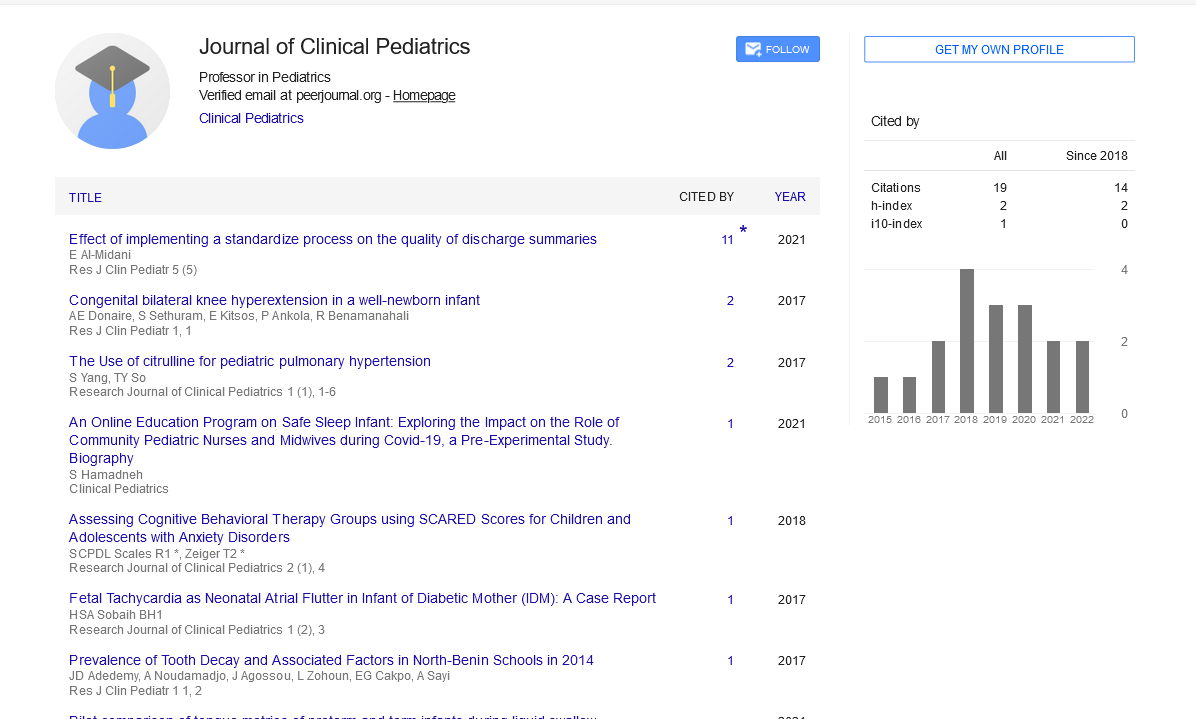Opinion Article, Res J Clin Pediatr Vol: 7 Issue: 2
Addressing the Environmental and Genetic Influences on Pediatric Obesity
Andrew Chris*
Department of Pediatrics, University of Milan, Milan, Italy
*Corresponding Author: Andrew Chris
Department of Pediatrics, University of Milan, Milan, Italy
E-mail: andrew_chris@um32.it
Received date: 22 May, 2023, Manuscript No. RJCP-23-105503;
Editor assigned date: 25 May, 2023, PreQC No. RJCP-23-105503 (PQ);
Reviewed date: 08 June, 2023, QC No. RJCP-23-105503;
Revised date: 15 June, 2023, Manuscript No. RJCP-23-105503 (R);
Published date: 22 June, 2023, DOI: 10.4172/Rjcp.1000144
Citation: Chris A (2023) Addressing the Environmental and Genetic Influences on Pediatric Obesity. Res J Clin Pediatr 7:2.
Description
Pediatric obesity has become a pressing global health concern, with its prevalence steadily increasing in recent years. While the complex interplay between genetics and environmental factors is known to contribute to the development of obesity in children, understanding the specific roles of each is essential for effective prevention and intervention strategies. Numerous studies have indicated that genetics play a substantial role in the development of pediatric obesity. The twin and family studies have consistently shown a strong genetic component in determining an individual's susceptibility to obesity. Certain genes related to appetite regulation, energy expenditure, fat storage, and metabolism has been identified as potential contributors to pediatric obesity.
The Fat Mass and Obesity-associated gene (FTO), for instance, has been extensively studied and found to be associated with increased Body Mass Index (BMI) and obesity risk in children. Variations in other genes, such as Melanocortin-4 Receptor (MC4R) and Leptin Receptor (LEPR), have also been linked to alterations in appetite control and energy balance, potentially influencing the risk of obesity. However, it is important to note that genetics alone do not determine the occurrence of obesity in children. Environmental factors play an essential role in either promoting or mitigating genetic predispositions.
The environments in which children live, grow, and develop significantly influences their risk of obesity. Environmental factors encompass a wide range of elements, including socioeconomic status, cultural norms, dietary patterns, physical activity levels, and access to healthy food choices. One key environmental factor associated with pediatric obesity is the obesogenic environment, which refers to an environment that promotes unhealthy eating habits and sedentary behaviors. Factors such as the increased availability and marketing of calorie-dense, nutrient-poor foods, limited access to fresh produce, and the prevalence of screen time and sedentary activities contribute to the obesogenic environment.
Socioeconomic status also plays a role, as families facing economic hardships may have limited access to affordable, nutritious foods and fewer opportunities for physical activity. Additionally, cultural and social norms regarding food choices and eating behaviors can influence a child's dietary preferences and patterns. The interplay between genetic factors and the environment is an essential aspect of pediatric obesity. While genetic predispositions may increase susceptibility to obesity, the expression of those genes can be influenced by environmental factors. This interaction is often referred to as the gene-environment interaction.
For instance, a child with a genetic predisposition to obesity may be more susceptible to weight gain in an obesogenic environment. Similarly, certain environmental factors can modulate the expression of obesity-related genes. An example of this is the interaction between the FTO gene and physical activity levels. Studies have shown that regular physical activity can attenuate the genetic risk associated with the FTO gene, highlighting the importance of an active lifestyle in reducing genetic susceptibility to obesity.
Understanding the roles of genetics and environmental factors in pediatric obesity is important for developing effective prevention and intervention strategies. Recognizing genetic predispositions can help identify children who may be at a higher risk of obesity, enabling targeted interventions such as personalized dietary and exercise plans.
Conclusion
Pediatric obesity is a multifaceted issue influenced by both genetic and environmental factors. While genetics contribute to an individual's susceptibility to obesity, environmental factors play a major role in its development. Recognizing the interplay between genetics and the environment is vital for effective prevention and intervention strategies. By addressing both genetic predispositions and modifiable environmental factors, one can strive to develop a healthier future for children by promoting positive lifestyle choices and reducing the burden of pediatric obesity.
 Spanish
Spanish  Chinese
Chinese  Russian
Russian  German
German  French
French  Japanese
Japanese  Portuguese
Portuguese  Hindi
Hindi 
